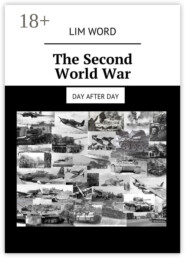По всем вопросам обращайтесь на: info@litportal.ru
(©) 2003-2024.
✖
All in order. Win the war
Настройки чтения
Размер шрифта
Высота строк
Поля
Losses of the parties in the Anglo-Iraq war. Britain – 1200 people, 30 aircraft, Iraqis – 8,500 troops, as well as 20 German, 4 Italian aircraft. Losses during the occupation of Iran: the USSR – 50 people irretrievably, 3 aircraft. Britain – 25 people, 8 aircraft. Iran – 800 troops and 300 civilians. The outcome of the operation “Consent” is the almost unimpeded delivery of more than 5 million tons of military cargo to the belligerent USSR. A small additional bonus to the Union – a significant part of the grain harvest of Northern Iran is spent on subsistence for the army. But now, in the autumn of 1941, the seizure of a considerable country of the East seems to be only a small drop of honey in a huge barrel of tar.Photo – British correspondent Alan Michi talks to the wounded in the course of the battle with the Iranians, a Soviet officer
The defense near Smolensk, 1941, July 10 – September 10. In the background – tanks T-26
The offensive of the German fascist troops near Smolensk, autumn 1941. Infantry with all the equipment, mortar men and T-4 tank of the first releases
Soviet gunners with 45 mm. gun. Surroundings of Smolensk, autumn 1941
German military inspect the Soviet tank KV-2 with a broken chassis. Even without enemy shells, the heavily loaded chassis of the KV-1 and KV-2 tanks often fail
Broken, probably by hitting an air bomb, the KV-1 tank. The main advantage of the Wehrmacht at this stage of the war is the high coordination between the various kinds of troops. In the composition of infantry, tank, and other combat units, there are necessarily airmen directing the Luftwaffe to the target, without additional negotiations with the commanders of the flight units
Vyazemskaya defensive operation, October 2—13, 1941 To the west of Vyazma the forces of Army Group Center are surrounded by four Soviet armies. Irrevocable losses of the Red Army – 250 thousand people, and 600 thousand prisoners. The losses of the Wehrmacht are unknown. Before Moscow there are now only scattered small groups of Red Army
Transported in freight cars, captured in Vyazma boiler Soviet soldiers. Photo on the cover of the German newspaper
Prisoners of Vyazma boiler
Soldiers of the Army Group “North” in the suburbs of Leningrad. The offensive is somewhat delayed and the inhabitants of the city manage to create the necessary fortifications. Also, the heavy tanks KV-1 and KV-2, produced by the Kirov plant
Since September 8, 1941, Leningrad, the second largest city in importance and importance of the USSR, as well as the adjacent territories are surrounded
The norms for issuing bread, the main or only food product, during the first two months of the blockade are reduced by five times. Since November 20, the minimum rate of bread delivery (employees, children and dependents) is 125 grams. Workers engaged in manual labor receive 250 grams of bread a day. In the photo – probably close relatives. It is believed that men suffer hunger worse than women
Some of the workers, not engaged in military production, go to the front. In this photo are workers of the Kirov plant. The fortification line is sometimes only 5 kilometers from important industrial sites, 16 kilometers away. from the Winter Palace
On the ice of the Ladoga Lake, in the circumvention of the positions of the Wehrmacht, the “Road of Life” is laid. Under the attacks of German aircraft, grain is imported into the city. Return flights are evacuating children. Since December 25, 1941, the rates of bread distribution have increased somewhat
Evacuation of Leningrad residents not engaged in defense and production
Finnish soldiers posing with torture Soviet prisoners of war, 1942. During the summer and autumn of 1941 Finland returns the territory lost in the Winter War. Further, the German-Finnish Karelian army continues the offensive, seizes Petrozavodsk and blocks Leningrad from the North. In the occupied territories, the Finns segregate the population on a national basis. Also, all responsible Soviet employees, enterprise managers, newspaper editors, policemen, etc., are sent to concentration camps. Justified hatred Bolshevik regime Finns mixed with longstanding own national aspirations. In a sense, Finland is hardly much better than fascist Germany. Ambitions of this sparsely populated country are constrained not by spiritual ideals, but perhaps only by its technical capabilities. July 30—31, an ally of the USSR, Britain, without declaration of war, inflicts air strikes on Petsamo and Kirkenes. One ship is damaged, two go to the bottom. The Air Force of England is losing 16 aircraft.December 6, 1941 Great Britain declares war on Finland.After the first defeat of the Wehrmacht, in the Battle of Moscow, Finland refuses to conduct active hostilities
German soldiers on the outskirts of Moscow. According to Hitler’s directive, the assault is conducted from September 30, 1941.
Sevastopol, 1941, the first assault, October 30 – November 21
Seamen of Sevastopol. On land, sailors form an elite infantry, fully aware of the value of combat brotherhood, and also accustomed to handling complex technology
Sevastopol, 1941
Sevastopol Air Defense Forces
Outskirts of Sevastopol, autumn 1941
Battleship “Sevastopol” is firing. The first and the second storm of the city of military glory are broken, first of all, thanks to the artillery support of the ships in the bays
Killed the KV-1 tank with dozens of shells, in the town of Venev, Tula region
The defense of Tula, November 1941. The important center of the Soviet defense industry is practically surrounded by German units, but it keeps the siege, and does not allow the Wehrmacht to strike Moscow from the south
December 28, 1941 RKKA and the fleet landed in Kerch, a day later – in Feodosia (Crimea). This operation is quite successful. Occupying Kerch, the German division is evacuated deep into the peninsula, throwing heavy equipme
Subsequent, poorly prepared and indecisive attacks on the fortified positions of the Wehrmacht are merely depleting the mechanized parts of the Red Army.
Killed the tank KV-1. District of the Old Crimea, the limit of advance of the Soviet marines
The erection of fortifications on the streets of the capital
Panic in Moscow, October 16, 1941
To overcome the fear of the Wehrmacht, an exhibition of disabled German military equipment is being organized in the center of Moscow
The battery is 85 mm. anti-aircraft guns in the Park of Culture and Rest. M. Gorky
Moscow, 1941. MiG-3 fighters. The capital is covered with impressive air defense forces, and Hitler’s plan to destroy the city from the air is not carried out
Two hundred thousand civilians and volunteers are mobilizing to help the Soviet Army in Moscow. Almost all of them die in the coming months
American poster in support of Lend-Lease
In November 1941, the first deliveries on lend-lease began. The country of the Soviets receives the first 670 aircraft, about 400 tanks and 3,000 other military cargoes from the United States and Great Britain. In the battle near Moscow, the armored vehicles “Valentine” and “Matilda II” account for approximately 35% of all tanks used by the Red Army. Lend-Lease aircraft, Tomahawks and Hurricanes form 16% of the air defense fleet of the capital of the capital
Moscow, November 1941. BT-7 tanks are sent to the front.
“Siberian”, in fact – the Far Eastern divisions, sent to Moscow after the assurances of scouts that there will not be any wars with Japan in the near future, represent the most prepared military formations
Moscow strategic offensive operation, November 1941
As a result of the Moscow battle, German troops were thrown 100—120 kilometers from the capital. Soviet soldiers for the first time see a significant amount of damaged and abandoned German equipment
The German motorcade, broken down near Moscow
German prisoners of war. Soviet troops take German soldiers for the first time in captivity groups, 10—15 people each
Pearl Harbor, the US Pacific military base
Harbor Pearl Harbor, modern photography. Approximately so, in color, almost 80 years ago, saw this all Japanese pilot
November 26, 1941, the US, seeing in the ambitions of the Pacific power threat to its security, declare Japan an ultimatum: to leave already almost conquered China, Indonesia and Korea. In response, on December 7, 1941, Japanese aircraft, with a belated declaration of war, strikes at the base of the US Navy in Hawaii (Pearl Harbor, Pearl Harbor, roughly in the middle of the Pacific Ocean). 2400 people are being killed, four battles of the First World War, four destroyers, 188 planes are sinking. Twenty-three submarines and, note, six aircraft carriers, the main strike force of the US Navy, which left shortly before the open ocean, remain intact. Losses of the Japanese side – 29 aircraft, 55 crew members, 9 submariners from five sunken ultra-small submarines. In the photo – the attack of “Zero” of the Imperial Air Force
Pearl Harbor, December 7, 1941
Japan is accompanied by a major initial success. Since December 8, 1941 samurai stormed the dominion of Great Britain, Hong Kong. After 18 days of defense, the garrison surrenders. 9000 British and Canadian soldiers are captured. The irrevocable losses of Japan – 2 thousand people, the Anglo-Saxon allies – 4 thousand. Expansion of the Pacific Ocean and continental China acquires a scale previously unthinkable. In the photo there is a parade of Japanese troops in Hong Kong, January 1941.
Since June 1941, thousands of echelons with people and evacuated equipment
The new plants built in Siberia and beyond the Urals sometimes represent flat sites, almost without walls, without a roof, with rows of machine tools on which military products are manufactured. As a rule, only women and teenagers work here
A teenager is 12—13 years old at work. For adults, work shifts last for 15—16 hours











